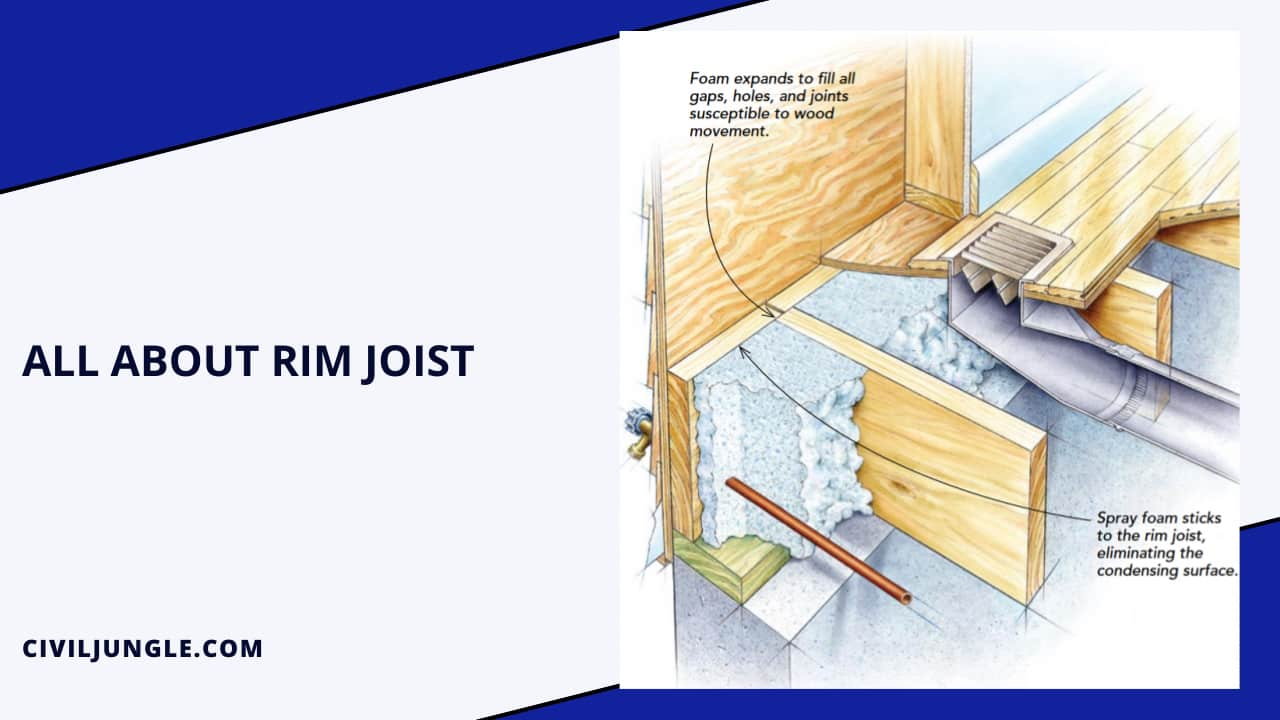
What Is a Rim Joist?
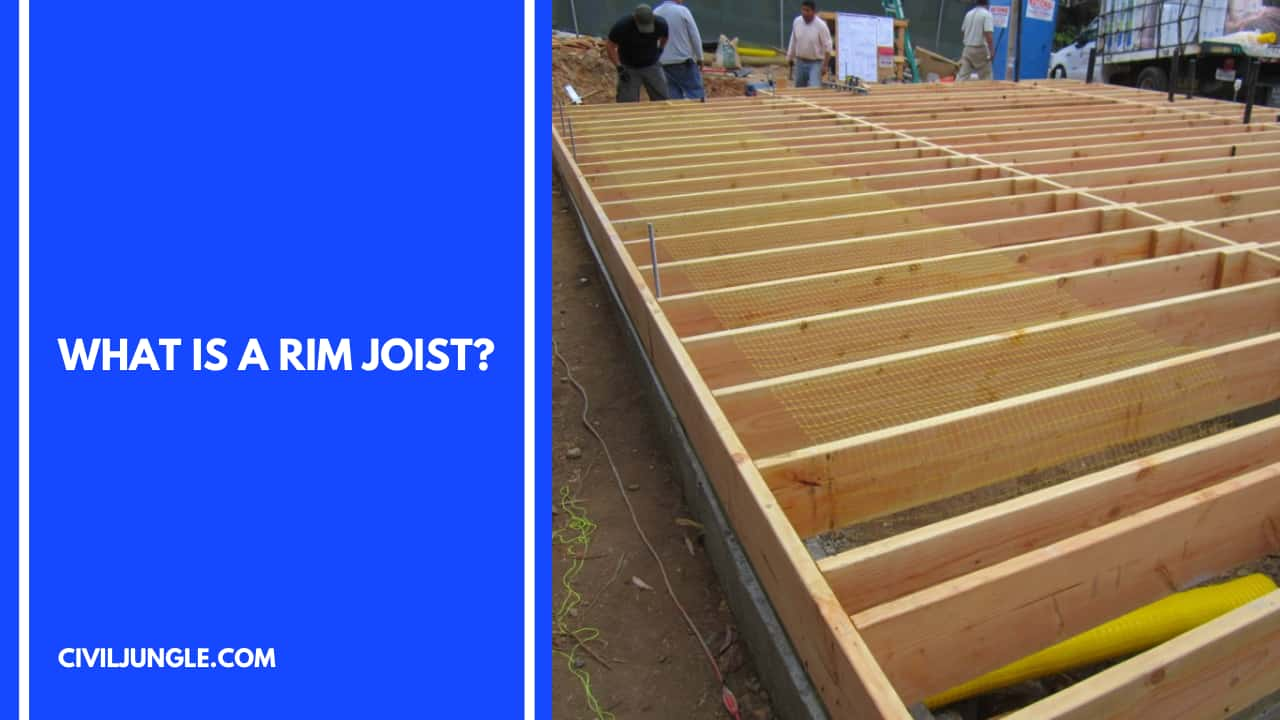
If you want to know what rim joists are then you should know about Joists first. In a house’s floor frame, there are many structural elements.
Some of these structural elements are primary structural elements.
Joists are one of these primary structural elements of the house floor frame.
Joists are like ribs of the floor frame. They build up the structure of the frame of the floor and then the joists are covered with plywood.
The plywood subflooring completes the platform of the floor.
On the outside ends of the joists, they are supported by the foundation structure or walls.
In an under-construction building, you can find rim joists. Along the bottom of each floor level, you could see a solid band of lumber running. These are rim joists.
The main structural element of a ceiling or a floor frame is called the rim joists.
The joists that are used to make the ceiling and the joists that are used to make the floor are formulated by using lumber of different sizes. It can be either a different-sized 2x standard lamb or engineered lumber.
After the framing work is all done, using plywood subfloor material floor joist rim board is covered, and then for finishing, flooring like wood, carpet, or tiles is used.
The space between the joists in the center is a minimum of 16 inches. A Rim joist is a structure that is made of wooden material.
The rim joists keep the floor frame wrapped from all sides.
In an under-construction house when the floor frame is being prepared, you will see a band of permanent lumber that runs along the side of the floor frame. This lumber is called a rim joist.
Rim joists, also known as band joist vs rim joist, are made to give additional stability and strength to the other joists used in the floor frame. Both ends of a joist typically are nailed into somewhere in the rim joists.
It does not let the floor joists tip over to the side.
Also, rim joists provide floor joist strength and keep the floor level and upright. After measuring and cutting the material, nails are driven into the floor joists from the rim joists.
Rim joists are placed on the top of the footing wall sill plate.
If another wall has to be built then it can be built on top of the rim joist but before doing it, on the subfloor, the plywood must be installed.
A house rim joist can be a load-bearing structure but it also may not be a load-bearing structure. It depends on whether something is built on top of it.
Also Read: What Size I Joist to Span 20′, 24′, 28′, 26′, 18′ and 16 Feet?
Useful Article for You
- What Is a Contour Interval
- What Is Tile
- What Is the Difference Between a Shower Pan and a Shower Base?
- What Is Raft
- What Is a Window Panel
- What Is a Frame Structure
- What Is the Measurement for a Queen Size Bed
- What Is Considered Livable Space
- Difference Between Lumber and Wood
- What Is One Way You Can Save Electricity?
- What Is Mdf Mean
- What Is a Bundle of Shingles
- What Is a Gallon of Water Weigh
- What Is Overhang
- What Does Low E Stand For
- What Is Sand Blasting
- What Is a Span Bridge
- What Is a Soil Stack
- What Is the Purpose of Foundation
- What Is the Little Black Diamond on a Tape Measure
- What Is a Louvered Door
- What Is the Strongest Foundation for a House
- What Is a Caisson
What Are Rim Joists For?
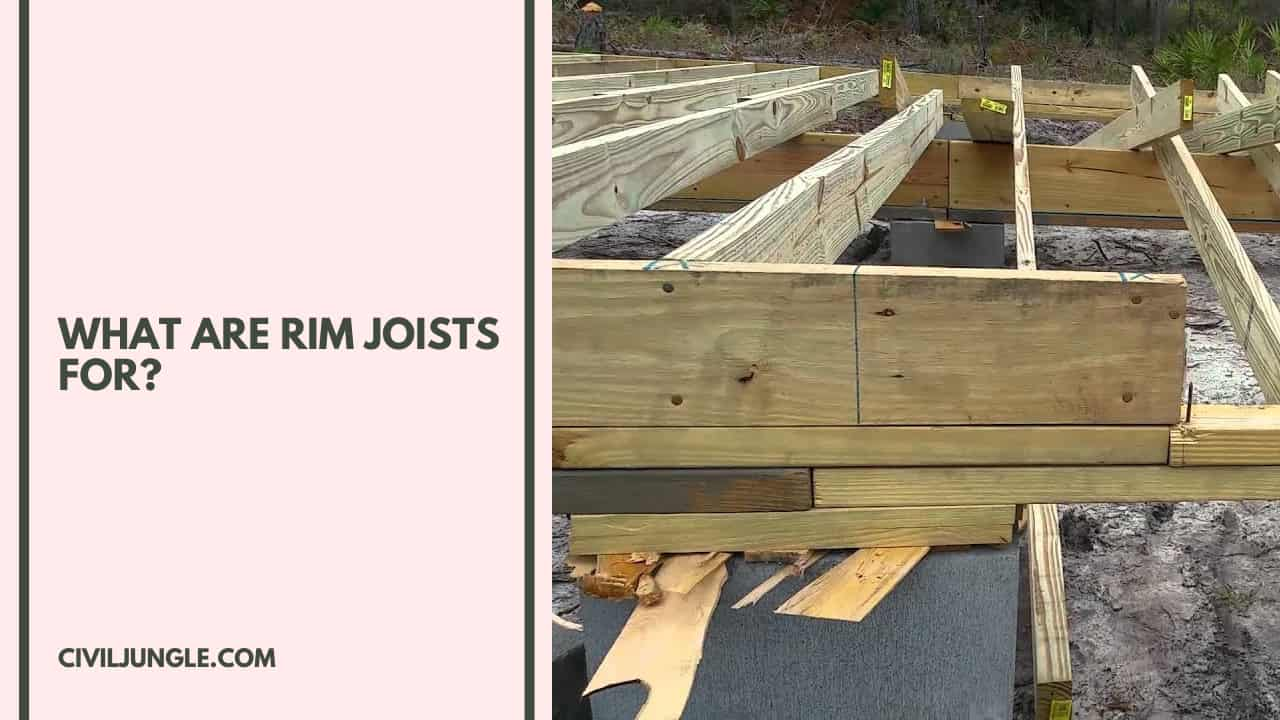
The most important purpose of rim joists is to deliver support to the other floor joists. To both ends of floor joists, rim joists are nailed.
It creates a strong, upright, and leveled outer edge.
On the edge of the floor, joist wood is nailed. This helps the floor to stay stable and keeps the floor joists strong and level.
On the base of a house along the perimeter rim, joists run. In many cases, people built exterior walls on top of rim joists. Building External walls make the rim joist a load-bearing structure.
If you run any pipe through the basement of your house, you will have to drill through the rim joist to fetch it to the outside.
To keep a house strong and tie the floor framing and wall together, you will need some wood chunks where you will be able to put nails.
Rim joists provide this chunk of wood.
In the case of decks, rim joists are not considered a weight-bearing structure because there is no wall built atop the deck.
But still, rim joists are very important. Rim joists keep the floor upright and give strength.
Rim joists also can support stairs and for additional strength, railing posts can be bolted into the rim joist. Rim joists are also called by another name.
They are also known as rim board vs rim joist. They provide support laterally to the joists.
Rim joists protect the joists from leaning, which is caused by the weight of load-bearing walls built on them, and their rim joist dimensions are crucial for this.
Another important feature of rim joists is that rim joists cover the joist cavity. The joist cavity is the space between two joists.
Rim Joist Size and Materials
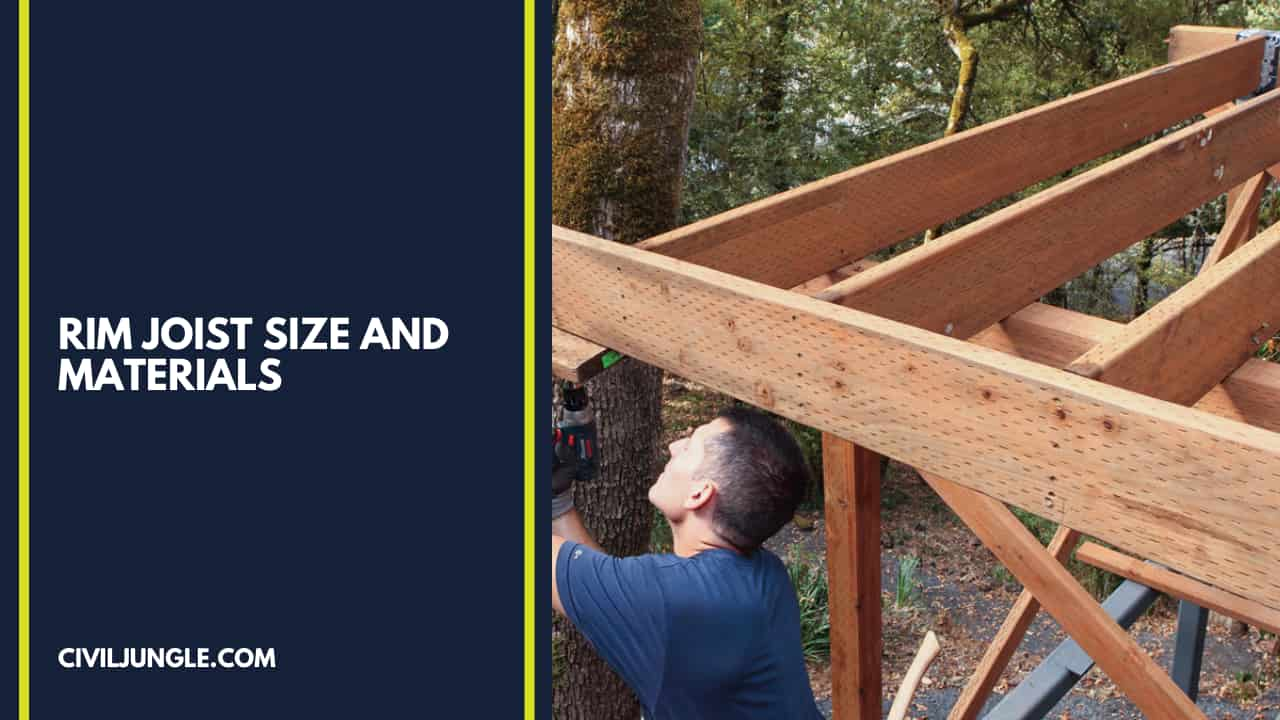
The material that rim joists are made of is not different from the materials that are used to make other joists.
It is the same material. If the frame is made of wood material then the rim joist would also be made of wood. If the frame is made of steel then rim joists made of will be used.
In some cases, the rim joist used is made of different materials from the frame.
They use rim joists made of steel with frames made out of wood. The architect or the engineer desires the nature of the materials of the rim joist and frame used. It also depends on the desired strength of the frame.
The rim joist width is not different from the size of other joists. It is the same.
So it keeps the rim joist level with the upper side and the lower side of the frame.
In some cases, the size of the rim joist and the size of other joists are different. If specifically said the rim joist is made smaller than other joists. In such cases, a hanger is used on the floor joists to secure the rim joist.
2x Framing lumber like the 2x 12 s, and 2x 10s is the most common material used to make rim joists. Joists can also be made of TJIs.
It is a type of engineered wood and it is a very strong material. This lumber is bigger than standard lumber.
In many cases, traditional lumber and engineered lumber are used together. Most architects use TJI floor joists and traditional floor joists of standard size 2x 12 together.
In some specific cases, steel joists are also used as rim joists, and with the steel joists, traditional lumber and engineered lumber are used together.
It depends on the design of the floor and the weight-bearing capacity.
Also Read: Best Color for Living Room Walls
Do I Need a Rim Joist?
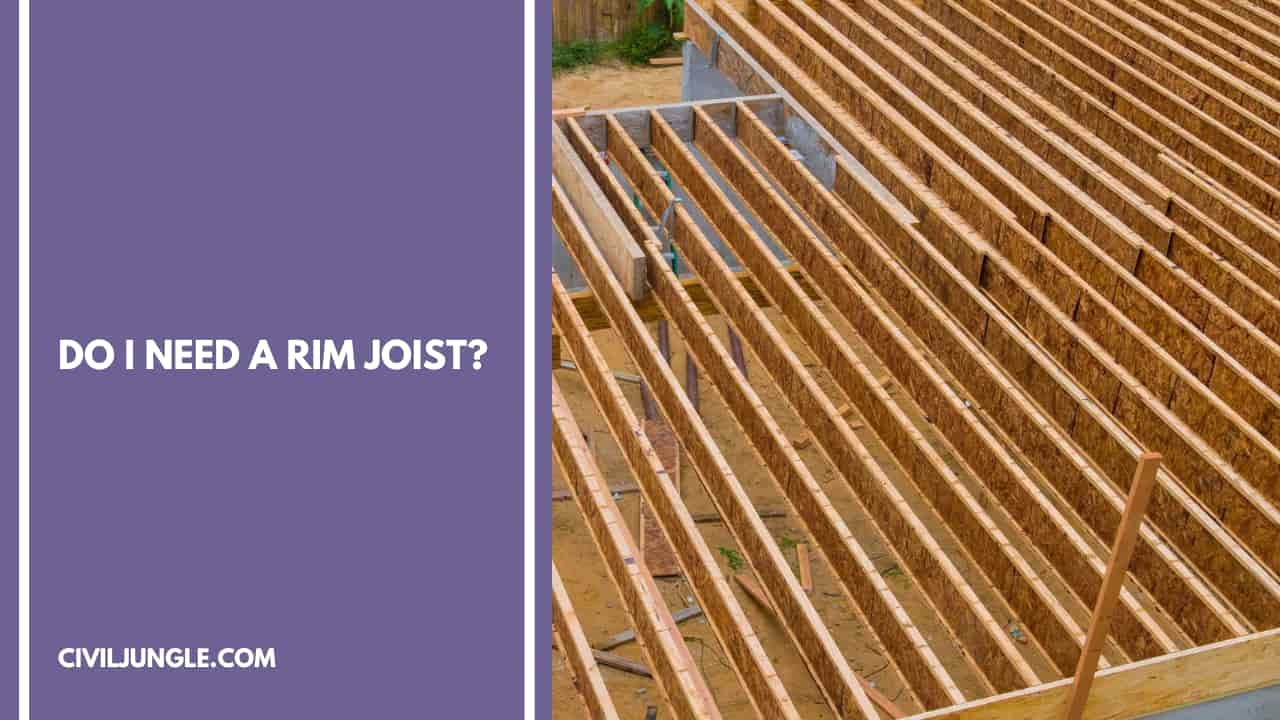
Yes. Of course, you need a what is rim joist in the floor frame of your house or the deck. Rim joists close the open space created along the four outer sides while making the frame.
To make a proper edge of the floor frame you will be needing rim joists.
It does not matter what type of floor framing you are creating, you have to attach rim joists. In the floor frame, assume that you are using standard 2x 10 joists.
There is approximately 16 inches distance between two joists. You will have to attach a ledger at the back of each joist. This gets bolted to the house.
The ledger is the rim joist of the back.
Whether it is a house or a building, a shed, or a deck, whatever it is, if it has a floor frame then you will need rim joists. In some special conditions, the rim is structural.
Rim joists give support to the floor sheathing as The rims sit on top of the frame.
For this reason, the rim joists must be strong enough. So the rim is secured to the floor frame.
Another reason you need to attach rim joists is that rim joists help to hold the rail posts.
If you are building a deck, then most likely, you will attach rail posts.
For this, you can bolt or nail through the rim joists. Rim joists are also a great place to secure a stair stringer.
Can You Drill Through a Rim Joist?
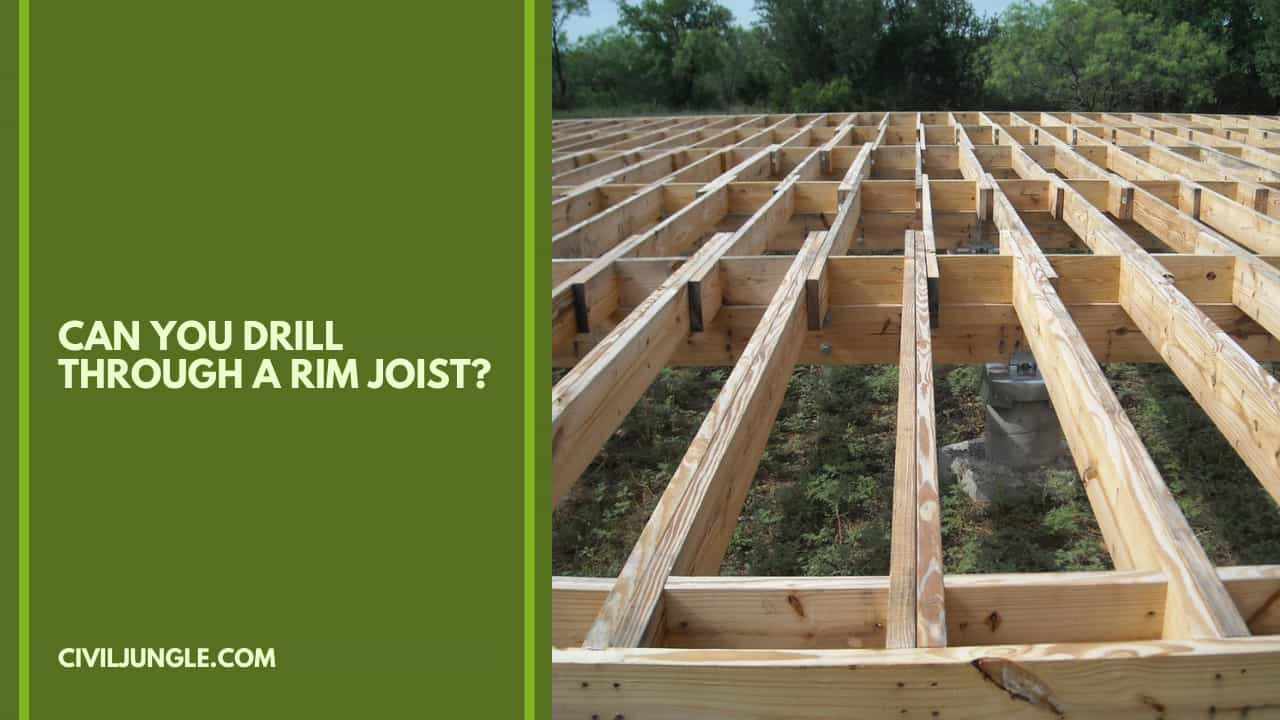
Yes. You definitely can drill through a whats a rim joist. If you run a pipe, wire, or vent through your basement, then you will have to drill through the rim joist.
One thing should be kept in mind while drilling a hole through a rim joist. If the hole gets bigger, then it will decrease the strength of the floor frame.
You can drill a hole through a rim joist, but the hole should not be very big.
After the installation process is over, make sure to insulate the hole with something.
To see gaps and small cracks, use foam. Spray it over the area, and you will notice if any crack is there.
Foam not only works as a great insulator but also keeps pests away from your house.
What Is the Difference Between a Band Joist and a Rim Joist?
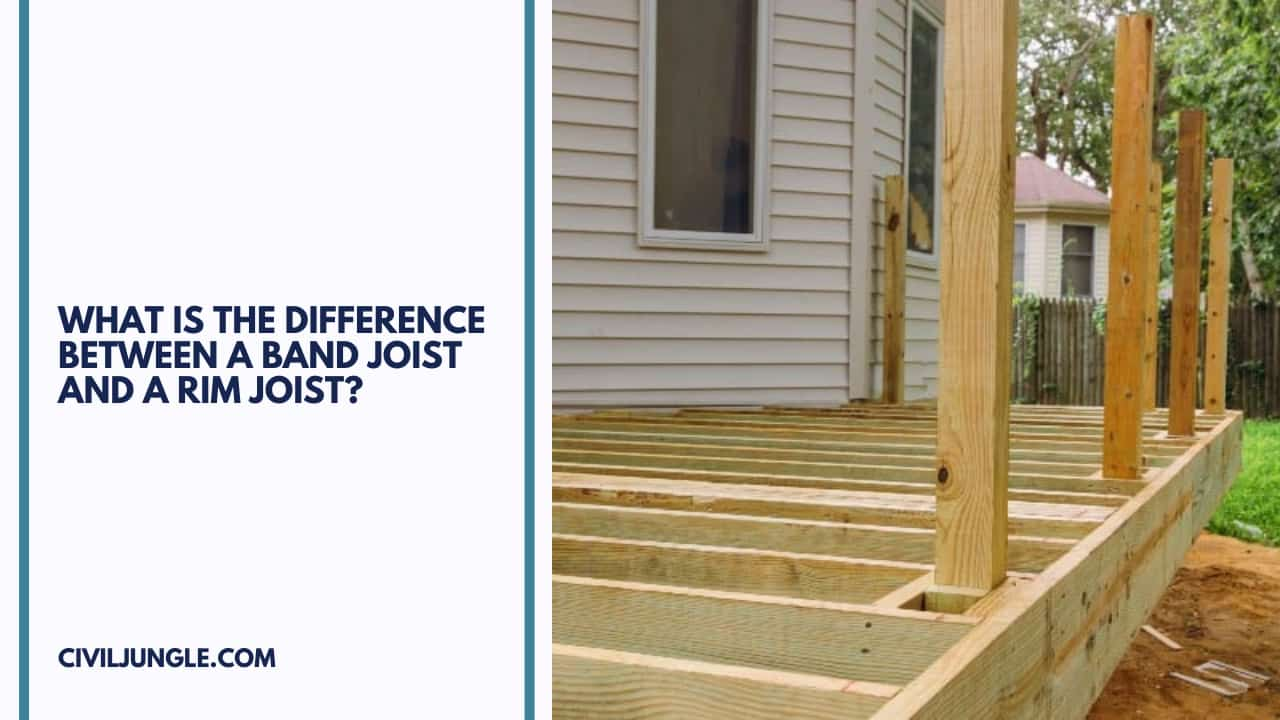
As mentioned earlier, the band joist and rim joist are the same things. There is no difference between these two terms.
Rim joists are attached to the frame joists perpendicularly. Rim joists cap off the open ends of a floor frame thus providing lateral support.
This part can be called by both the terms a rim joist and band joist. Both the terms indicate the same thing.
Useful Article for You
- Moment Frame
- Monolithic Slab
- Zero Force Members
- How Much Does a Yard of Concrete Weigh
- Cmu Wall Meaning
- Gradient Road
- Pile-Cap
- Budget Sunroom Ideas
- What Is Gypsum Board
- Types of Vaulted Ceilings
- Well Points
- How Does Baking Soda Remove Blood from Carpet
- What Are Forms in Construction
- How Heavy Is Dirt
- Tender Meaning in Architecture
- Dark Olive Green House
- Cast in Place Concrete
- Lean to Roof
- Spandrel Beam
- Sheeps Foot Compactor
Can Rim Joists Be Replaced?
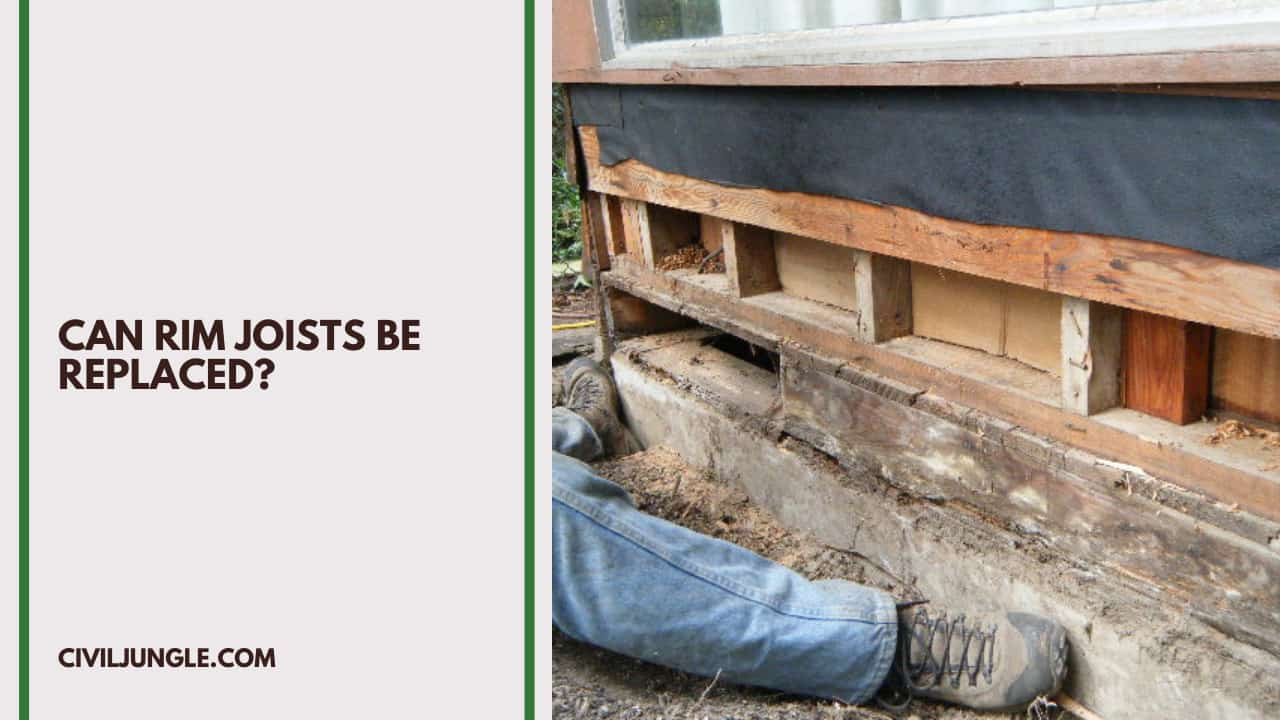
Many folks seem to be confused about the replacement of rim joists. Whether replacing it is possible or not. Well yes, it is. Rim joists can be damaged by many things like rain and insects.
So if a rim joist is damaged you will have to replace it with a good one.
Cut out the damaged part from the rim joist. Replace it with perfect measurements. This process is done from the outside of the house.
At first, the removal process of the damaged part begins with removing the sliding and sheathing parts that expose the rim joist.
Some strappings, bolts, and hangers also needed to be removed. If any piping, wiring, or vents are there then remove them before cutting out the damaged part.
After the completion of the entire process reinstall the waiting, piping, or vents.
If the floor frame is too old and not in very good condition then it is better to use some support while removing the damaged section.
So before you start the removal process check everything carefully and then initiate.
After you have done the inspection, take proper measurements of the damaged section. Cut the damaged section as per the measurements.
Replace this section with new material. Reinstall the wiring, piping, vent hanger, sheathing, straps, and hangers. And now the floor is all set.
How to Install Rim Joists?
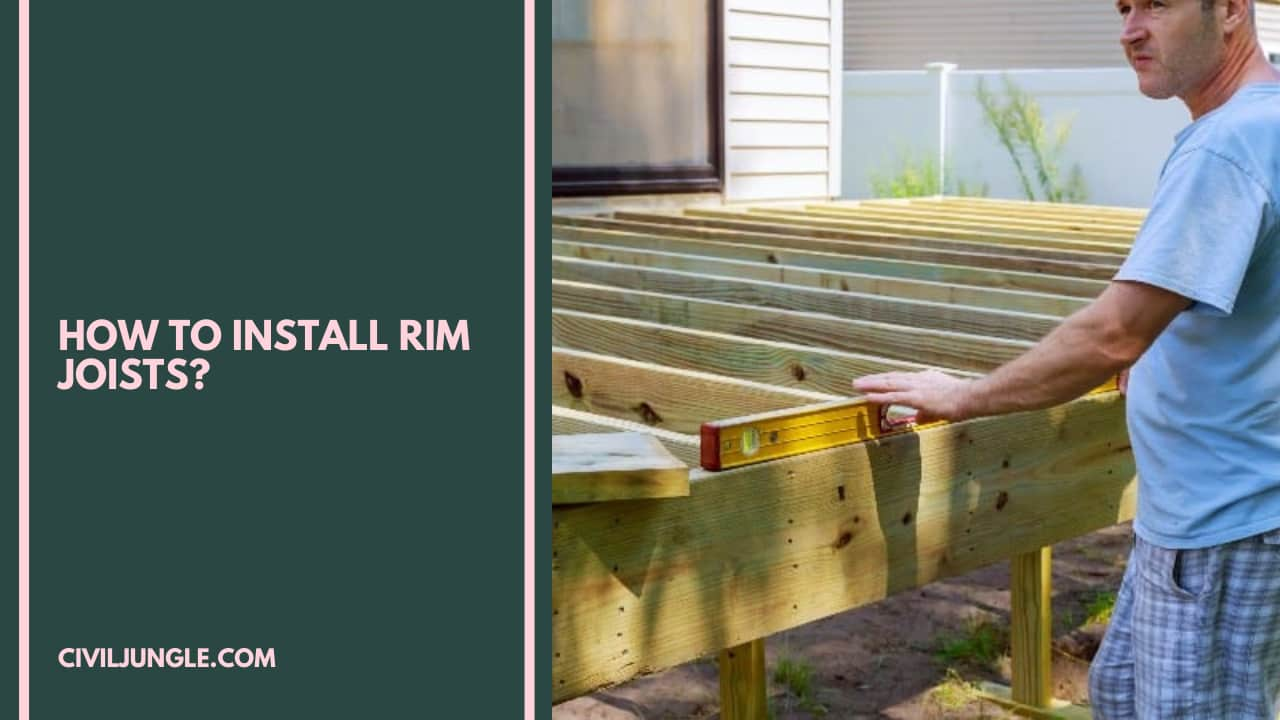
Rim joists run in a specific direction. This direction is determined by the architect and engineer. But commonly in a rectangular house rims run from the front to the back of the house.
Running the rim joists this way requires the least amount of material.
Architects or engineers want to use as least material as possible. Because short joists prevent flexing, they try to prevent the structure from flexing.
The joists need to be as long as the span is.
Each of the rim joists runs parallel to the longer side of the house if it is rectangular. For this reason, rim joists take a perpendicular position to other joists.
The floor joist of the outermost side is called the end joist. They are not to be mistaken as rim joists. Rim joists are always fixed in a perpendicular position.
Spotting rim joists is very easy as they look like the letter T if seen from above.
Rim joists are fixed either on the upper-level walls or the foundation walls. The upper-level walls mean the top palate and the foundation walls mean the sill palate. Then framing nails are used to frame them into the palate.
To reinforce the connection metal straps can be used. These metal straps are called tie downs. You can look for these straps at any lowes or home depot.
Strapping gives additional support to the rim joists so they do not get separated in high winds and earthquakes. The straps keep the structure tied.
From the outside edge of the rim joists, joist nails are driven through into the butt of the joists.
Thus rim joists are nailed to each joist.
This connection is extremely strong and it keeps the floor joist stiff and level.
If traditional lumbar rim joists are used with engineered floor joists then hangers will be needed.
Should You Insulate Rim Joists?
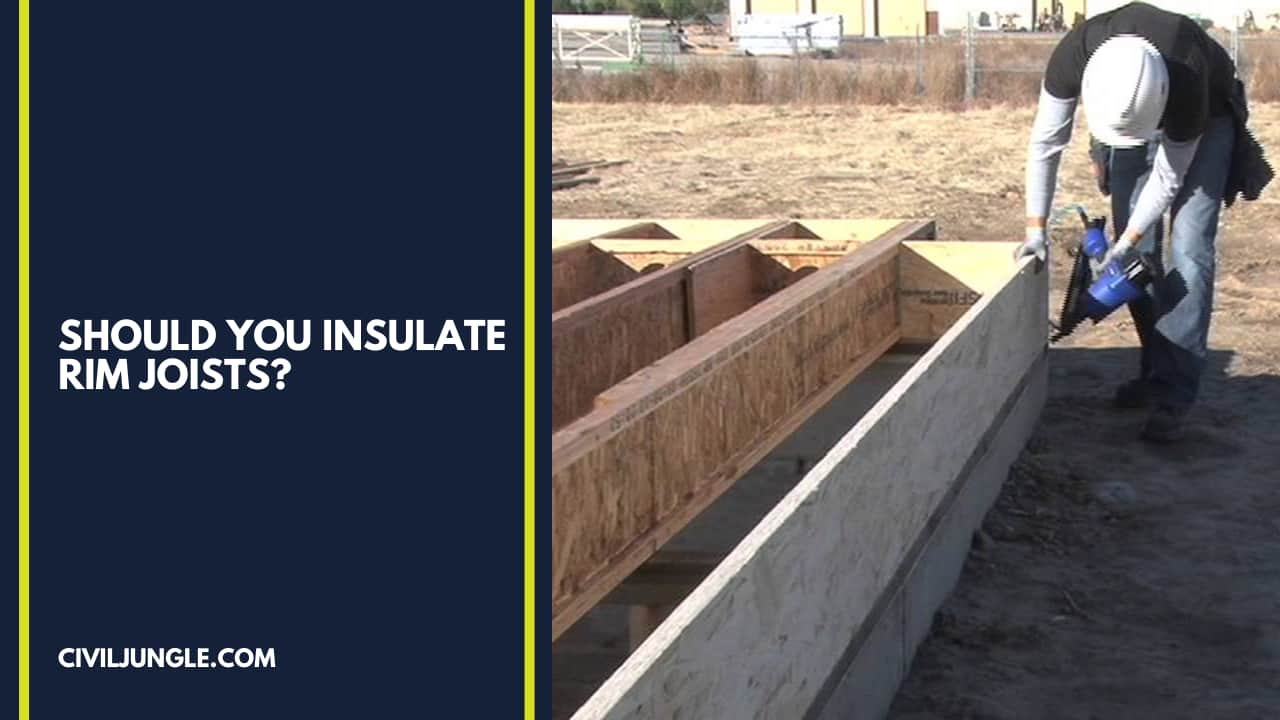
Experts say that the more insulation you can get it is better for your house. Insulation means less heat will pass through the walls.
It helps to keep the house warm in winter as well as cool in summer, and knowing the rim joist insulation cost can be beneficial.
By insulating, you can maintain a consistent temperature when you turn on the AC or heater. This way you could save a lot of energy and money.
The insulation process of the rim joist is very easy.
If you are building a new house then you can get a rigid foam insulation board and install it, considering lvl rim board sizes in a way that the foam covers the rim joists.
Or in an old house, you can cover the inside of a rim joist with insulation.
It can be done from the basement. To insulate the rim joist you should use air impermeable insulation because the rim joist is prone to drafts.
It includes rigid foam, batt, or spray. While spraying the foam, seal the edges carefully so no gap remains there. It will keep air and moisture away.
If you want to insulate the rim joist by using fiberglass, then it may let moisture and air in. This moisture and air can lead to mold problems.
So you should spray foam along the edges of the wood. It will create a better seal.
What Is a Rim Joist?
In the framing of a deck or floor system, a rim joist is attached perpendicular to the joists, and provides lateral support for the ends of the joists while capping off the end of the floor or deck system.
What Is a Band Joist?
Band/Rim Joist: Band joists, also sometimes called rim joists, are just joists at either the side or end of the deck. There’s nothing special about them. In fact, unless you’ve got stairs attached to one of them, band/rim joists only have to carry a fraction of the load that the regular floor joists do.
What Is Rim Board?
Rim board sits on the sill plate and forms a band around the perimeter of an engineered wood floor system, matching the full depth of the joists. Thanks to its connections to the floor membrane, sill plate, and joists, it transfers vertical and lateral loads. This way, it helps the floor system act as a unit.
What Is a Rim Joist on a Deck?
A rim joist on a deck is a horizontal board that runs around the perimeter or edge of the deck, providing support for the joists that run perpendicular to it. It is typically attached to the ends of the joists and helps to stabilize the structure.
What Is a Double Rim Joist?
Double rim joists commonly are only used for inset or flush beams, or to create a picture frame finish. An exception is to strengthen spliced rim boards, to minimize bounce, or for more substantial mass to fasten railing posts to.
What Size Rim Joist for Deck?
Joists and rim joists to which guard posts are attached shall be a minimum of 2×8 nominal.
Is a Rim Joist Structural?
Rim joists serve a critical function in distributing the load of the structure above to the foundation below. In a two-story home, the rim joists bear the weight of the wall, the upper floor, its wall, and the roof. They also work with two outer joists, forming a band for the floor’s framework.
Rim Joist Vs Band Joist
Rim joists are set perpendicular to the joists so as to provide lateral support for the joist ends. Keep in mind that rim joists are not the end joists which primarily are the first and last joists that make up a floor or deck frame. The rim joists and the end joints together form the band joist.
What Is a Rim Joist on a House?
Rim joists are located at the top of your basement walls. They usually look like wooden squares going around the perimeter of your basement. The main purpose of a rim joist is to support the weight of the floor resting on the joists.
What Is the Best Way to Insulate Rim Joists?
On rim joists, install foam-based or vinyl-faced fiberglass batt insulation tightly to the cavity and seal at all edges. Use fire-rated material if the insulation is to be left exposed.
Do I Need a Double Rim Joist Deck?
The rim joist only needs to be doubled if it’s acting as a supporting beam for the rest of the joists. If the joists are sitting on top of a beam, the rim joist can be single.
Do You Need a Double Rim Joist on a Deck?
It is advisable to increase the rigidity and strength of your deck’s rim or perimeter in order to reduce bounce and provide a solid foundation for your rail system. This can be accomplished in a couple of ways. You may want to install double rim joists across long sections to respond to the flexibility of the material.
Where Should You Not Drill Holes in Joists?
No holes closer than 2 inches to the top or bottom edge. No holes closer than 2 inches to any other hole or notch. No notches in the middle 1/3 of the joist, but holes are permitted here. No notches deeper than 1/6 the joist depth.
Can You Drill Through Rim Joist?
Yes you can drill your rim joist.
Should You Insulate Rim Joists?
But the job isn’t truly complete until you seal basement leaks, too. This is where rim joist insulation comes in. Proper insulation along the rim joists of your home’s foundation helps eliminate air leaks and keeps moisture out; it also creates a strong thermal barrier at the base of the building envelope itself.
Joist Notch Reinforcement
Tradespeople often need to cut notches or holes in floor and ceiling joists to run pipes, ductwork, or wires. Sometimes joists are notched at the end where they bear on a wall or sill. If the cut-outs are too large or in the wrong location, the joist can be weakened and unable to support the load it was designed for.
Do I Need a Double Rim Joist on My Deck?
A double rim joist is not always necessary for a deck. It depends on factors like deck size, load, joist spacing, and local building codes. Consulting a local professional is recommended.
How to Install Rim Joist on Deck?
Step 1: Attach Rim Joist
Measure and cut the rim joists to length. Set one edge of a rim joist on the beam with the top edge of the other end flush with the ledger. Fasten the boards with two 3-inch deck screws. Fasten the other rim joist the same way.
Is It Worth Insulating Rim Joist?
Sealing and insulating your rim joists is a great way to minimize the loss of heat in your home. Insulating rim joists consists of sealing up any existing holes with a type of insulation, such as spray foam insulation. The new insulation fills the holes and prevents heat from escaping through them.
Like this post? Share it with your friends!
Suggested Read –

